There may be no other topic as widely discussed right now in any global political sphere as “going green.”
Ten years to safely remediate and dismantle every nonrenewable-energy power plant in the United States. Even for those unfamiliar with the complexities, demands, or inner-workings of industrial demolition could probably tell you off-hand that that seems ambitious. But this figure is the very same that’s been cited or benchmarked in various political agendas — both on state and federal levels — for the better part of half a decade now.
With the help of the National Demolition Association, a survey was distributed to nationwide industrial demolition contractors everywhere to get their take on a plan of this scale’s viability. After all, they’re the ones more or less exclusively tasked with the literal heavy-lifting. More than anything, however, what their disparate responses unearthed was a deeply-rooted lack of a common understanding between contractors of various sizes and experience levels.
And, moreover, an inescapable deficiency in the size, experience, and support of the existing workforce to handle a project of this immense magnitude.
THE SURVEY
The theme of this exploration is “bandwidth” in the industrial demolition industry. In terms of equipment, resources, experience, and most importantly workforce, does an entire industry have the capacity to execute a task this wide-ranging and far-reaching? After all, “non-renewable energy sources,” as various pieces of legislation often cite, most often targets coal and other “dirty” forms of energy, but can also include oil, gas, and nuclear.
Together, these non-renewable power sources continue to have an iron grip on the country’s infrastructure. Coal-fired power stations alone constitute roughly 23% of overall energy production across the United States while nuclear comes in a close second at 20%. Natural gas-fired power plants, which are exponentially more efficient than coal but still non-renewable, are responsible for the largest portion of the nation’s energy consumption with nearly 38% of all energy consumption. Natural gas power plants dwarf the total number of both coal-fired and nuclear power plant facilities across the country.
We asked the 4,500 demolition contractors in the National Demolition Association network a short list of questions that covered three main points:
- Are there enough qualified demolition contractors to achieve this 10 year goal?
- Are there enough qualified and experienced employees to safely manage and execute this task?
- If not 10 years, how long would this take?
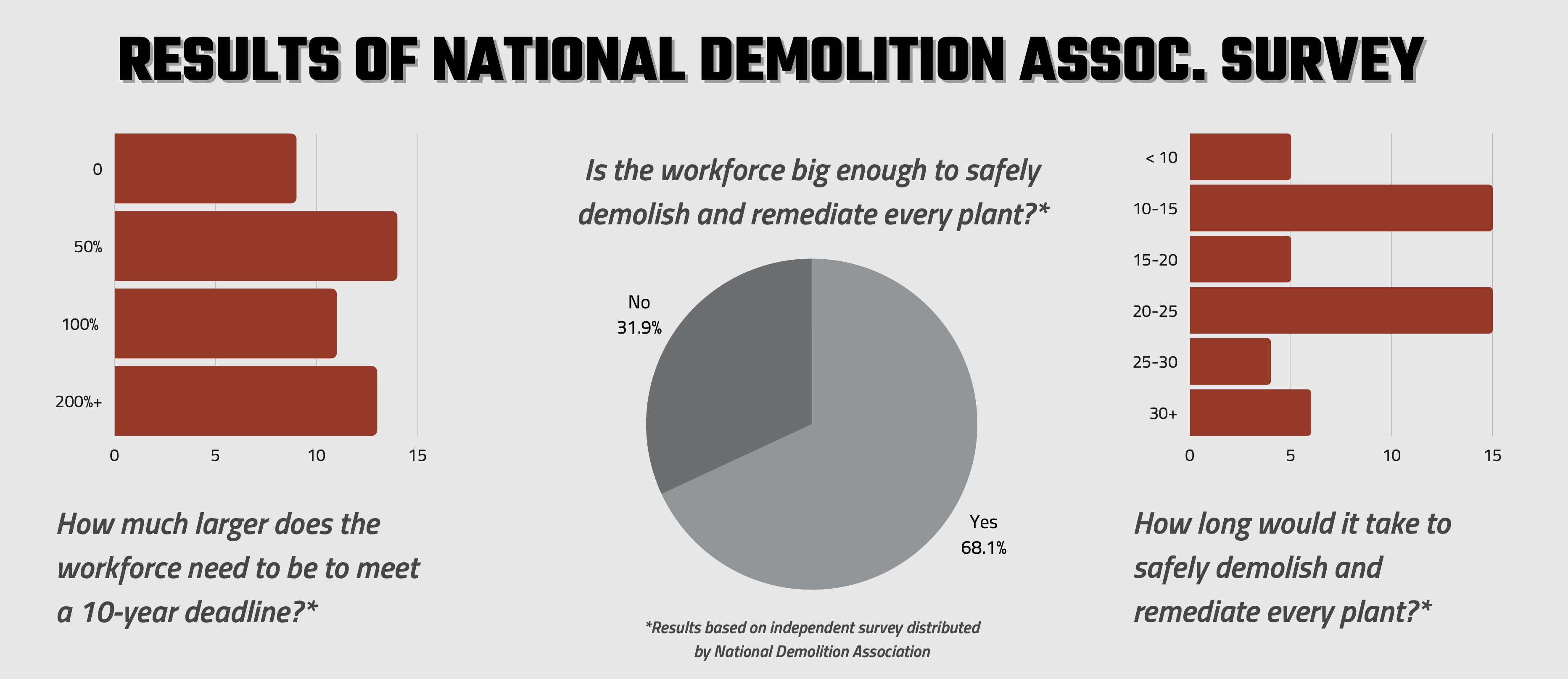
Responses fell on an even 50/50 split when broadly asked about the viability of completing a project within 10 years. produced an even 50/50 split: half of the contractors believe it’s possible, half do not. But the ratio skewed the more we zoomed-in on project specifics.
For example, only 30% of respondents believe that the workforce is currently large enough to safely complete a nationwide decommissioning. Funnily enough, when pressed to guess how much bigger the workforce may need to be, only 19% of respondents maintained that the existing population was sufficient. Conversely, 51% believed it would need to be twice as big (the other 30% believed the workforce would need to be around 50% bigger).
The responses grew only more disconnected, revealing a widening gap between the answers of smaller, less-experienced optimistics and long-standing realists. If there was any sort of consensus, it existed somewhere in between a lack of a realistic comprehension about what a proposal of this magnitude implies, and, more urgently, what a piece of such grossly ambitious would demand. The all-hands-on-deck strain it would put on contractors nationwide.
And, more seriously, the immense and inevitable pressure to cut corners, expedite timelines, and deprioritize safety in the interest of meeting an impossibly aggressive timeline. A sad reality of the industry is that not every contractor has the same safety rating, nor the same respect for or adherence to its prioritization.
The last question in our survey circled back to a broad, high-level view at the task. If every single demolition contractor got to work today, how long would this epic decommissioning take? 36% believed that it would take between 15 and 25 years. 32% said upwards of 15 years while 21% believed it would take 25 years or more.
Only 10% held on to the possibility that it could be completed in 10 years or less.
SAFETY FIRST
What needs to be kept at the forefront of everyone’s mind is that we’re talking about industrial demolition here.
By its very definition, this is one of the most dangerous, hazardous, and life-threatening lines of work anywhere in the world. Safety is absolutely paramount through every single step, an interest religiously protected by a series of extremely delicate, tested, and well-worn processes that ensure projects run smoothly and safely while minimizing any amount of potential risk.
There’s a tragic lesson that’s been learned since the inception of the industry, from the very first time a wrecking ball flew through a wall: the minute a less reputable demolition company begins cutting corners in the interest of saving time or reducing the overall project cost, or making any effort to expedite this or any other crucial phase of the process, people die. There are no two ways about it.
Trying to find creative ways to circumvent that extremely black and white reality is akin to asking a heart surgeon to hurry, or to skip a step. Or do less research before diving in. It’s impossible. And if that surgeon we’re forced to rush or cut corners, the possibility of someone getting seriously hurt is a matter of “when” not “if.”
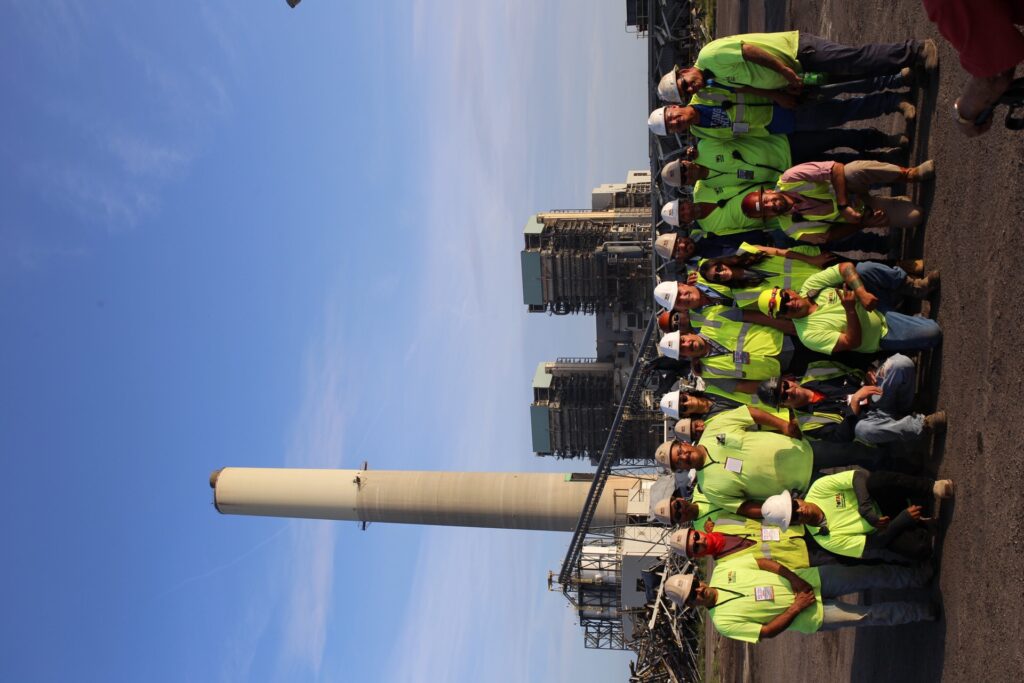
ARE WE ENOUGH?
The last version of a demolition contractor “census” conducted by the National Demolition Association was in October of 2019, when they counted just north of 4,500 demolition companies (comprised of around 25,000 employees) registered across the United States. At first blush, that seems like a formidable army of professionals to tackle the wide-scale dismantling and remediation required.
Total Wrecking and Environmental has made its mark over the last couple of decades handling the largest, most dangerous, and deeply complex projects the industry offers: power plants. Total Wrecking CEO Frank Bodami, as well as a handful of other industry-leading power plant demolition experts who contributed to this story, estimate that the realistic number of companies with the necessary size, expertise, equipment, infrastructure, and training to safely complete work of this magnitude is much closer to 15. Meaning the mammoth task at-hand falls on far fewer shoulders.
The safe remediation, demolition, and redevelopment of smaller sites that power factories, mills, or schools take on average 6-8 months to complete for a company of Total Wrecking’s nationwide reach and expertise. Bigger industrial power plants, however, like the ones that power entire cities, easily require 1-3 years to complete. Even for Total Wrecking, among the most reputable, capable, and well-equipped demolition companies in the country, two or more simultaneous power plant demolitions would be enough to stretch them to their infrastructural limits. Any more volume than that poses the very real, and incredibly dangerous, risk of overburdening a company’s resources.
What this deliberation also fails to account for are the smaller-scale demolition needs of the everyday working world. This assumes everyone is working exclusively on power plant demolitions, and none of the community projects, small-to-midsize cleanups, and other demolitions that need to be managed and handled simultaneously. Even if the path to a ten-year finish was clearly paved, would there be any leftover resources, equipment, or experienced personnel to spare for everything else?

THE WORKFORCE ISSUE
There’s been a decades’ long workforce decline within the construction industry as younger generations increasingly opt for tech-oriented work, regardless of their educational history.
Total Wrecking and Environmental has the deep experience and managerial capacity to certify and train industrial professionals, as well as a self-serving desire to continue handing down their expertise to in-house personnel. The issue is a dramatic lack of professionals willing to do the work, much less interested in training to do the work. Younger generations simply aren’t interested in entering the demolition industry. Meanwhile, the existing talent pool continues to age out.
This one-way trend has been decades in the making though it’s effects grow more obvious each year as multi-decade professionals continue to age out at an increasingly high rate. As the problem worsens, and with an utter lack of incoming youth, demolition companies are left to steal and trade existing professionals, a practice that’s become a small epidemic of its own.
Industrial demolition is a highly-qualified and specialized craft that requires extensive training but otherwise has few barriers of entry. Aside from a lack of interest, there’s also an obvious lack of awareness around industrial demolition careers. You won’t find any industrial demolition recruitment tables in any high schools. There are no established institutions that focus on industrial demolition education, nor is there any formalized curriculum available at any academic level that paves a path towards an industry role.
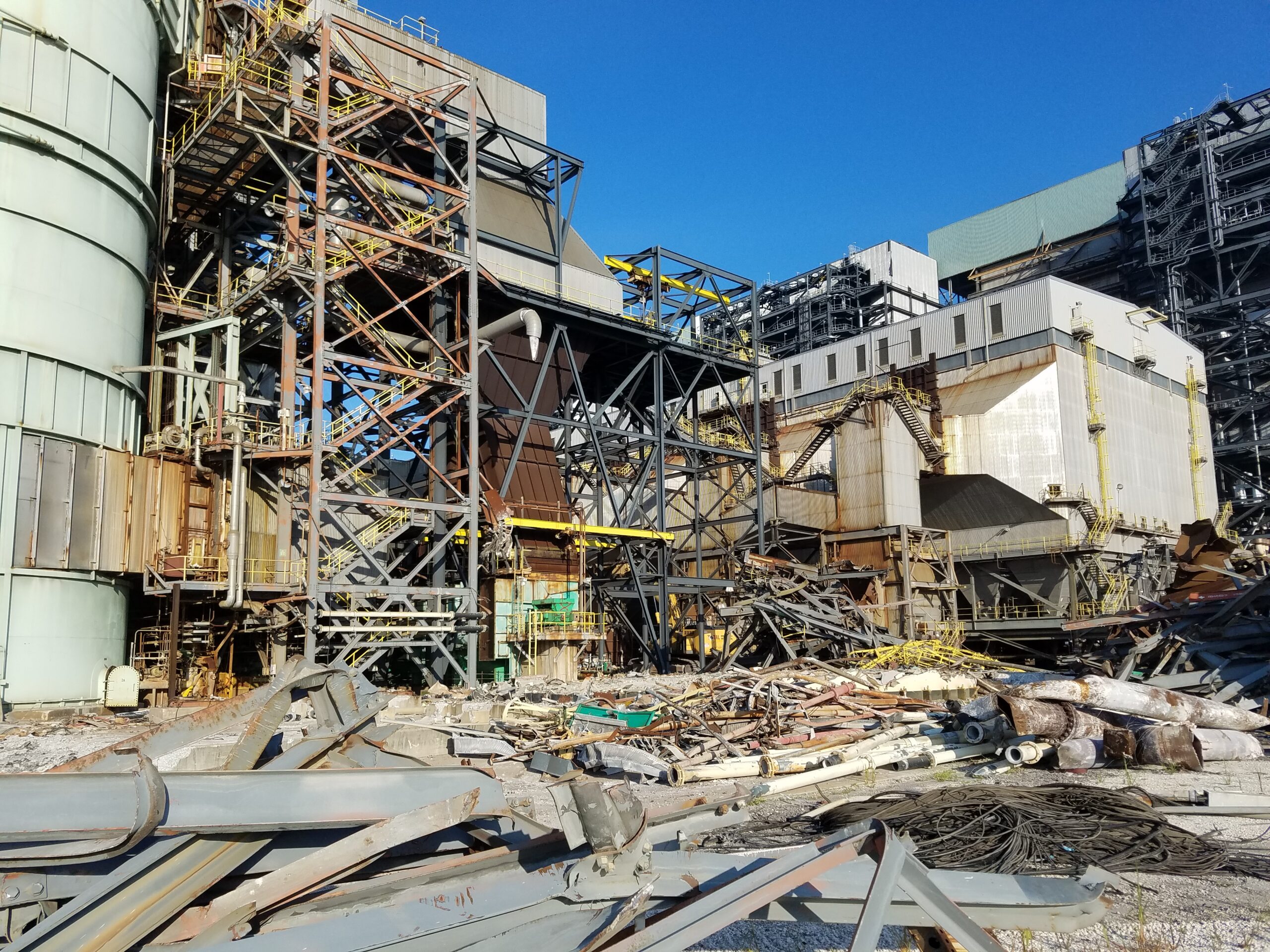
Work development training programs do exist, particularly in areas like Buffalo, NY (Total Wrecking’s center of operations) where industrial work is more prevalent than other corners of the country. There have also been fleeting attempts to establish an industrial demolition curriculum in places like Penn State University. But none produce the turnout, volume, or interest needed to shift the overwhelming tide.
All that to say: are there still enough professionals around to safely manage the most ambitious, wide-ranging demolition project in history? Total Wrecking and Environmental CEO Frank Bodami believes the total industry workforce needs an additional 500 demolition professionals to make a ten-year timeline remotely feasible.
Not 500 young-and-hungry recruits with freshly printed GEDs or BA’s (although that would be tremendously helpful in invigorating a scalable, longer-term workforce). He means 500 experienced and qualified Project Managers, Equipment Operators, Mechanics, Welders, Superintendents, Safety Supervisors, High Burners, Tradesmen, General Contractors, and so forth. The solution to the ailing industry’s labor deficit is, unfortunately, not exclusive to any specific part of the workforce. No demolition contractor we spoke with had an issue with the idea that the necessary equipment could be sourced, gathered, and assembled in time.
But to make this project even remotely possible, the industry needs people. Everywhere.
HOW MANY POWER PLANTS ARE THERE?
The main villain in the eyes of green-conscious politicians are coal-fired power plants, monstrous and decades-old facilities responsible for powering entire cities. The last verified count completed by the Energy Information Administration from 2019 and counted 308 coal-fired power plants.
Although some argue that nuclear power is a relatively clean(er) alternative to coal worth maintaining, it’s likely that any sweeping green legislation would also target the nation’s remaining 58 or so nuclear power plants.
These counts, however, don’t necessarily translate to “unique sites;” power plants, after all, can have multiple energy sources. The EIA’s calculation is based on the predominant energy source for one or more generators on a given site, meaning a “natural gas power plant” that produces predominantly natural gas-powered energy has one or more generators also producing coal-fired energy, that power plant will be counted as both a natural gas power plant and a coal-fired power plant.
Power plants can also change their energy sources. In recent years, it’s in the interest of using more efficient natural resources, like natural gas, to produce “cleaner” energy that isn’t renewable or “green” but significantly more environmentally friendly than coal.
While some non-renewable energy facilities do undergo site-wide retrofittings, it’s more common for non-renewable plants to decommission generators producing certain types of non-renewable energy, modify them to produce more efficient or renewable energies, or install new generators producing different types of energy altogether. All of these possible facility retrofittings, compounded by regular status code changes, have a significant impact on previously posted data year-to-year.
In other words, it’s encouraging to look at the EIA’s table of industrial power plants and see that the number of coal plants has decreased from 589 in 2011 to 308 in 2019. That’s a huge shift in the right direction! Of that 281 difference, however, the NDA clarified that only 164 coal-powered decommissioning projects have been completed while the remaining 117 sites have been converted to burn other types of fuel.
That’s still an objectively admirable decrease in non-renewable energy reliance and a show of the industry’s capacity to facilitate a massive transition to more efficient energy sources. But considering the hundreds of coal-powered and nuclear plants that remain online, exponentially more work would need to be done in roughly the same period of time to meet legislative agendas.
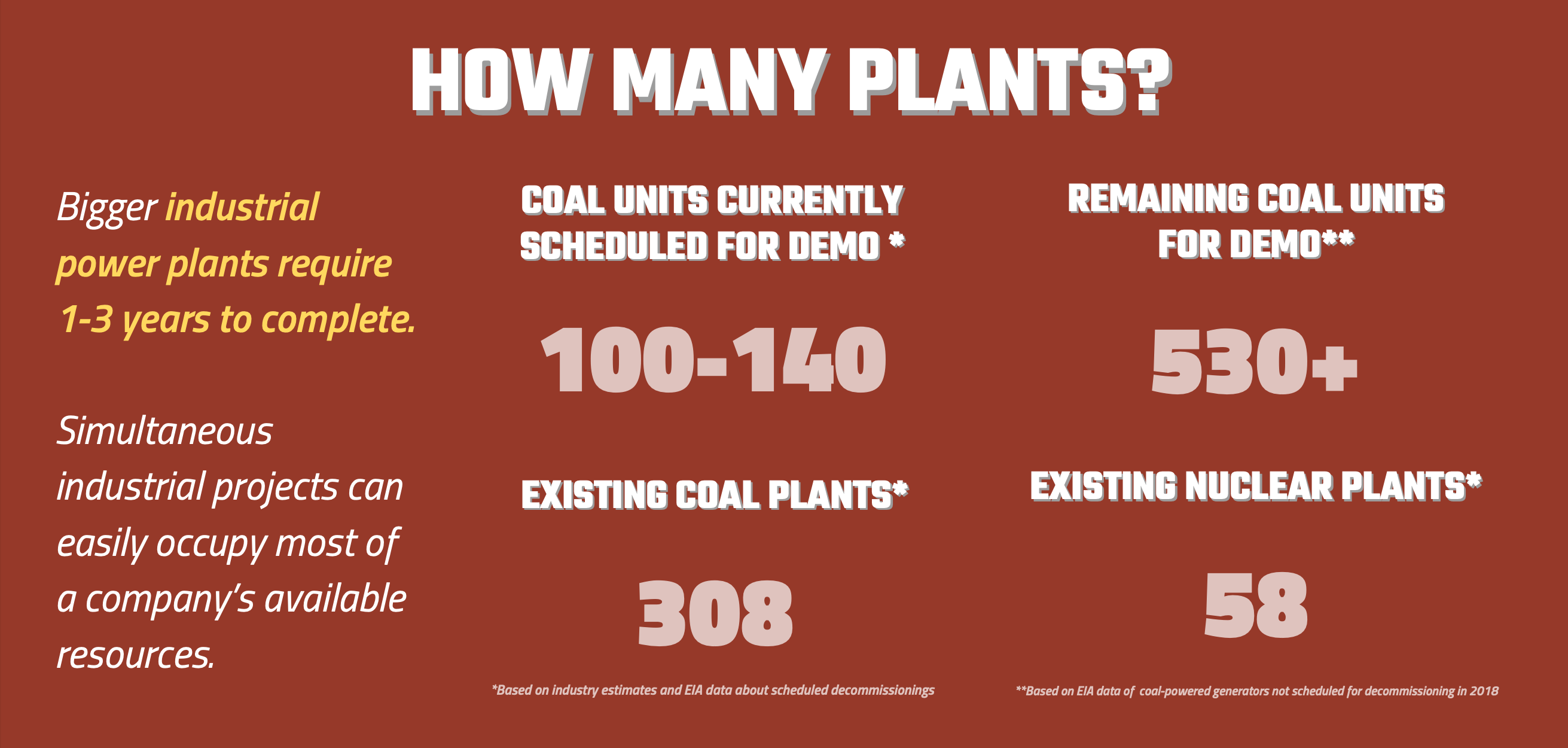
5 nuclear reactors across 3 sites have been scheduled for decommissioning this year, which constitutes roughly 5% of the U.S.’s overall nuclear generating capacity, a sizable decline that the EIA states is a result of increased competition from renewable energy sources (and historically low natural gas prices). The U.S. Nuclear Regulatory Agency has project management responsibilities for 18 reactors also scheduled for decommissioning.
The EIA reports that more than 30 GW worth of announced retirements are planned between now and 2024, with total coal-fired U.S. generating capacity dropping to 200 GW by 2024. Additionally, they expect retrofitting or retirement of 60-100 GW of capacity by then, which amounts to roughly 100 coal-fired units over the next 5 years.
That’s all fine and well to keep the industrial demolition business booming, but these numbers are still well short of what sweeping legislation would require. And considering that the largest coal-fired plants often require 1-2 entire years to completely remediate, dismantle, and redevelop, we’re looking at an undertaking far beyond the closures and retrofittings already planned between now and 2024.
WHAT THE INDUSTRY NEEDS
Other than the size of the workforce and a strict preservation of traditional project timelines, what else needs to happen within the industry to make a project of this scale possible?
In future terms, making industrial demolition a larger part of the education system so that young people can follow a well-defined path to the industry is a start. But beyond youth, uniting the entire industry under a clearly defined company-agnostic curriculum, from the client to the customer to the workforce, would go a long way in educating the industry as a whole about the necessity of demolition and the extraordinarily delicate processes that protect its safety and integrity.
Uniting contractors, power plants owners, and communities alike under a collective understanding of an industrial power plant demolition’s complexity and sensitivity would help create smoother, cleaner, faster, and safer projects across the country.
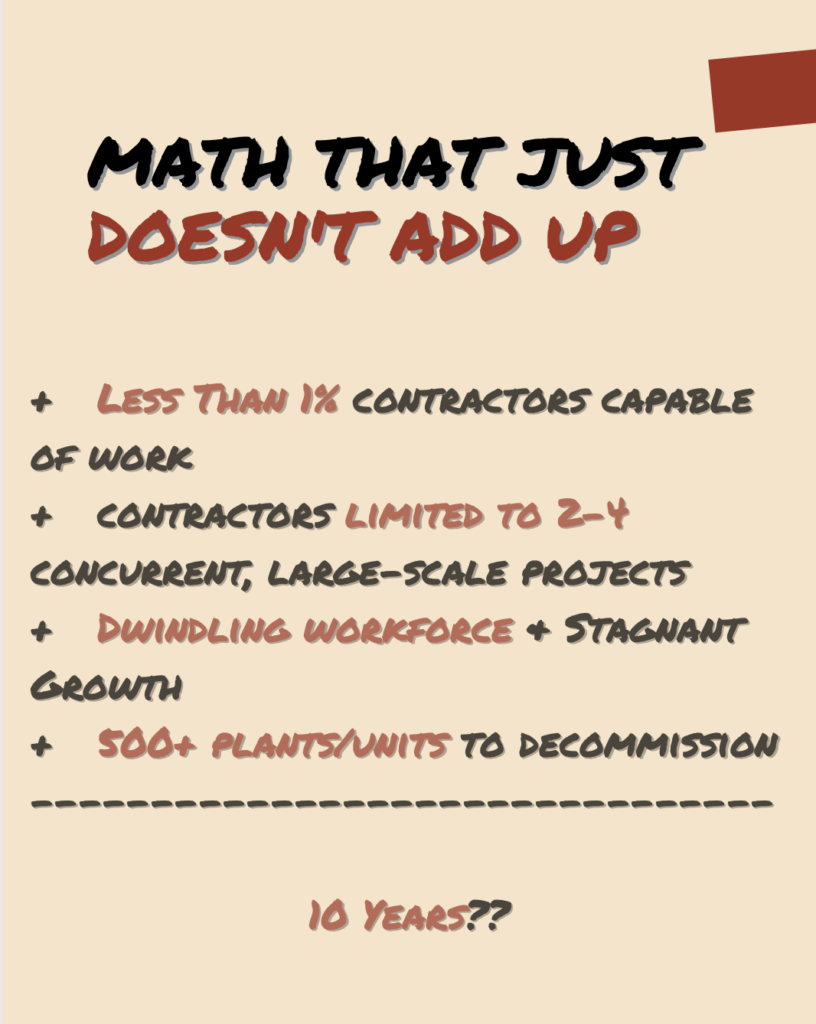
Injuries and accidents remain a massive issue. People continue to get hurt, or worse, and the insurance rates are astronomical as a result. A rising industry trend is for power plants to be sold to development companies looking to break even, and are therefore most concerned about the bottom dollar, and cutting whatever corners necessary in its interest.
These redevelopments are cheap and fast, often completed with little to no concern for labor or community safety and no qualified management or oversight. Often they’re not even completely environmentally remediated, meaning left-behind hazardous elements continue to pose immediate and long-term risks to the larger community even after redevelopment, a tremendous liability that remains the plant owner’s legal responsibility even after an exchange of ownership.
In the meantime, we can only hope that educated paths to the industry become more clearly defined. That the workforce is provided a second wind and doesn’t continue withering away. That development companies stop exploiting power plant owners in the name of the cheapest bid. That power plant owners increasingly recognize the importance of their own plant’s dismantling. That communities continue to be protected and prioritized.
And that hard-working laborers stop dying along the way.
SOURCES
NDA
Total Wrecking and Environmental
https://www.eia.gov/energyexplained/electricity/electricity-in-the-us.php

